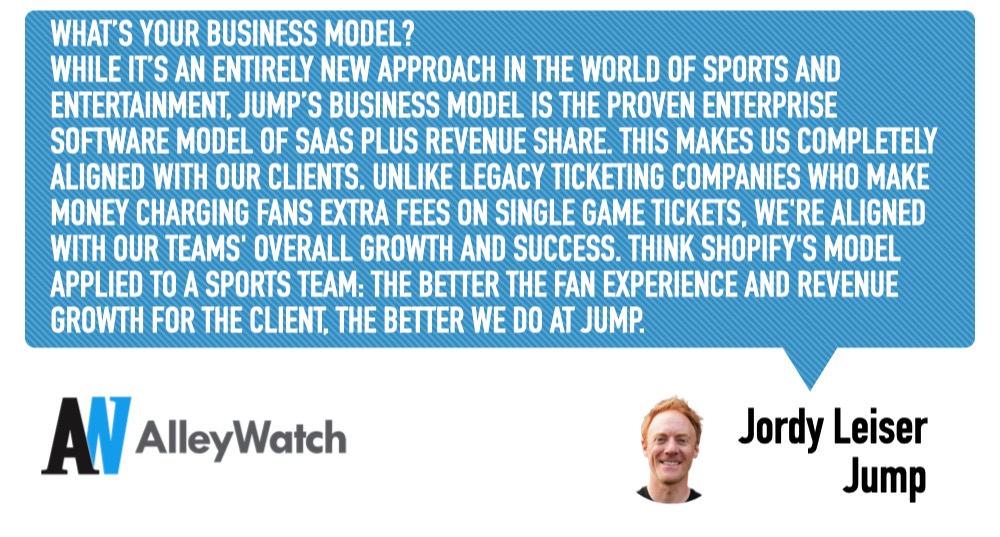Professional sports teams operate in a $100B+ global market growing at 19% annually, yet most front offices remain trapped by outdated technology that wasn’t built for their needs. Legacy ticketing platforms, retrofitted from the concert industry when paper tickets were still the norm, force teams to surrender control of their most valuable assets – fan data and direct relationships – while piling on fees and limiting flexibility. Jump solves this by delivering the first unified fan experience platform purpose-built exclusively for sports, combining ticketing, marketing, white-labeled apps, and team websites into a single system that gives teams complete ownership of their fan journey from first tap to final scan. The platform enables teams to create personalized multi-game bundles, send targeted in-app messages, reward loyal fans with credits, and optimize pricing – all based on real fan data rather than fragmented point solutions. With early results showing 3x increases in in-season season ticket sales and 33% growth in multi-game attendance, Jump has already launched with NBA and WNBA teams including the Minnesota Timberwolves and Lynx, replacing entire stacks of disconnected legacy tools.
AlleyWatch sat down with Jump CEO and Co-Founder Jordy Leiser to learn more about the business, its future plans, recent funding round that brings the company’s total funding raised to $60M, and much, much more…
Who were your investors and how much did you raise?
We raised a $25M Series A led by Alexis Ohanian’s Seven Seven Six, with Courtside Ventures, Will Ventures, Drive by DraftKings, and Forerunner Ventures participating, in addition to several team owners and Ryan Tedder. The people who most intimately know the challenges and opportunities of running a pro sports team are our investors. We think that says a lot.
Tell us about the product or service that Jump offers.
Jump is the only unified fan experience and ticketing platform purpose-built for sports teams. We give teams full control of ticketing, their fan data, their web and mobile apps all in one system — no more fragmented tools or competing marketplace dynamics. With Jump, teams can finally go direct to their fans and own and control the end to end fan experience.
What inspired the start of Jump?
When my cofounders Marc Lore and Alex Rodriguez entered sports ownership, they were shocked by how broken the fan experience is. Fans bounce between multiple platforms and disjointed digital interfaces as they attend games, and teams don’t have full control over their fan data, fan communications, marketing and messaging — the legacy ticketing companies do. We built Jump to fix that. One unified platform where teams control everything — from the user experience to the data to the economics.
How is Jump different?
Jump is vertical software and AI that helps sports teams run their business. Unlike a siloed ticketing marketplace or a mobile app developer or a martech solution, we bring these mission critical solutions under one seamless system, giving teams complete control. Jump is not designed to profit off a team’s fanbase like the legacy ticketing companies are. Jump is different: a team’s brand, data, fans belong to the team, not the ticketing marketplace. No redirects, no competing offers, no unnecessary fees. Plus, we’re purpose-built for the needs of sports teams — Jump is not a concert platform retrofitted for a sports team.
What market does Jump target and how big is it?
The global live sports market is over $100B and growing 19% annually. Every sports team benefits from the capabilities of Jump’s platform, and the early results prove it works.
What’s your business model?
While it’s an entirely new approach in the world of sports and entertainment, Jump’s business model is the proven enterprise software model of SaaS plus revenue share. This makes us completely aligned with our clients. Unlike legacy ticketing companies who make money charging fans extra fees on single game tickets, we’re aligned with our teams’ overall growth and success. Think Shopify’s model applied to a sports team: the better the fan experience and revenue growth for the client, the better we do at Jump.

How are you preparing for a potential economic slowdown?
Jump actually helps teams weather downturns. Our platform enables teams to lower costs and complexity with fewer vendors and gives them the data and flexibility to optimize pricing and engage fans more effectively and efficiently. When times get tough, teams need maximum efficiency — that’s exactly what we deliver.
What was the funding process like?
Investors immediately grasped the opportunity. Having sports tech leaders like Alexis Ohanian, as well as Courtside and Will Ventures validates what we’re building.
What are the biggest challenges that you faced while raising capital?
The sports ticketing industry hasn’t seen real innovation in 30 years. Convincing investors we could take on entrenched incumbents required proof. That’s why our early success and results with NC Courage were crucial — demonstrating strong execution and actual impact, not just promises of a lofty vision.
What factors about your business led your investors to write the check?
It is easy to see the opportunities Jump can bring to pro sports teams, which have been underserved by incumbents for a long time. Teams have been trapped in systems that lock up their most valuable asset — their fan data and fan relationships. Jump liberates that data and gives teams the control and tools they need to actually use it.
What are the milestones you plan to achieve in the next six months?
Complete successful and impactful seasons with the NC Courage and NCFC as well as launch with the Minnesota Timberwolves and Lynx — our first NBA and WNBA partners. These early adopters will prove Jump works and delivers results at all levels of professional sports, creating powerful case studies for others to see.
What advice can you offer companies in New York that do not have a fresh injection of capital in the bank?
Stay relentless. We spent four years building toward this moment, adjusting tactics based on changing circumstances outside of our control, but we never wavered on the vision. If you’re solving a real problem and the market wants what you’re building, keep pushing.
Where do you see the company going now over the near term?
Nail it, then scale it. We have the perfect opportunity this year to showcase what Jump can do for professional sports teams. We’re eager to prove what’s possible when clubs own and control the fan relationship. Once we prove the impact of Jump with our early adopter partners, it’s about scaling in a responsible way and becoming the standard for how modern teams and leagues engage their fans.
What’s your favorite summer destination in and around the city?
Nothing beats heading out to the US Open at the end of summer. The energy of a match, the crowd, and grabbing some merch is the perfect late-August weekday for me.






















